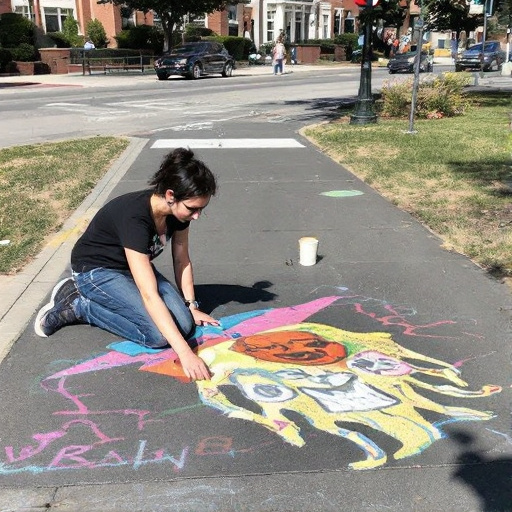Featured Articles
- "Chalk Art and Activism: How Campus Sidewalks Became a Canvas for Expression and Outrage"
- Quiet Quitting: The Unseen Impact of Minimalist Student Engagement on Campus Life Dynamics
- The Forgotten Art of Dining Hall Cuisine: A Culinary Exploration of Campus Life's Hidden Delights
- The Secret Life of Campus Pets: Uncovering the Furry Friends Behind Student Success Stories
- Top 6 Innovative Backpacks for Campus Life Revolutionizing Student Organization and Comfort Since 2019
"Whispers in the Quad: Exploring the Surprising Rise of Campus Cryptid Culture Among Students"
"Whispers in the Quad: Exploring the Surprising Rise of Campus Cryptid Culture Among Students"
The rise of cryptid culture on college campuses is a phenomenon that has captured the imagination of students seeking entertainment, community, and a bit of thrill in their daily lives. As legends like Bigfoot, Mothman, and campus-specific monsters spread through whispers in the quad, they weave a tapestry that connects generations of learners, transforming even the most skeptical scholars into enthusiastic storytellers.
The Allure of the Unknown
Cryptids embody something deeply human: the fascination with the unknown. As college students, we are at a time in our lives where we are often grappling with existential questions and searching for meaning. A study by the Pew Research Center found that 60% of students expressed a desire for deeper connection during their college years (Pewresearch.org, 2020). Cryptid culture offers not only a thrilling escape but also a unique form of bonding over shared excitement and exploration.
The Digital Age and the Spread of Mystique
Thanks to the internet and social media, folklore has never been more accessible. TikTok, Twitter, and Reddit are bubbling cauldrons of stories, memes, and alleged sightings that feed the ever-growing interest in campus cryptids. One viral TikTok of a supposed Sasquatch sighting in Oregon State University even led students to form a Sasquatch Society, symbolizing a shift from traditional campus clubs to more whimsical associations born from shared lore.
Case Study: The Mothman of West Virginia University
In 1966, the town of Point Pleasant, West Virginia, was allegedly visited by a creature that many described as Mothman—an enigmatic figure with large wings and glowing red eyes. Over the years, this legend has crept into the halls of West Virginia University, spawning an entire subculture among students. Each October, the Mothman Festival sees thousands of students and locals come together to celebrate this fusion of history and mythology, blending local tradition with youthful exuberance.
Encouraging Creativity
Another aspect of this cryptid resurgence is its role in fostering creativity. Many students are channeling their inner writers, artists, and filmmakers through projects that revolve around these elusive creatures. For instance, the 'Campus Cryptids' project at the University of Colorado Boulder invited students to submit original cryptid lore for a potential anthology, showcasing narratives that meld both humor and horror. The winning story, "The Boulder Beast," was a delightful mix of ghostly encounters and existential dread that resonates with the student body.
"Did You Hear That?" - Conversations in the Quad
Campus life provides the perfect backdrop for cryptid conversations, which often erupt in the most ordinary places. Picture this: a group of students lounging on the quad when one pops the question, “So, do you believe in ghosts?” Instantaneously, a spirited discussion ensues, each person recounting their own personal ‘close encounter.’ Studies indicate that social connection through storytelling can enhance our wellbeing, with folklore acting as a bridge between individuals (Habaradas, 2022).
Popular Cryptids on Campuses
As students share tales, many cryptids begin to take on specific characteristics linked to the university setting. For example, "The Hobo Ghost" at the University of Southern California supposedly roams the old buildings, while "The Toad Man" at whichever campus you’re on may be known for mischievous pranks that lead to unexpected outcomes. Students take pride in these local legends, creating channels of camaraderie and a sense of belonging.
Humor Is Key
One of the most entertaining aspects of cryptid culture is its capacity for humor. Who doesn’t laugh at the thought of a “Chad-squatch” trying to fit in at parties? Comedy is interwoven into the telling of these stories, with students creating memes and videos that poke fun at their own fears. One recent TikTok parody of "Mothman" shows a student dramatically screaming at their roommate: "Don’t go out tonight! Mothman is on the loose!" Moments like this remind us that even in the darkest legends, there's room for lightheartedness.
The Benefits of Belief
Engaging with cryptid lore is not simply about enjoying a good scare; it also has psychological benefits. According to psychology professor Dr. Jonathan Galassi, folklore can serve a purpose equivalent to traditional religious narratives: "Myths and stories provide comfort, community, and sometimes even a moral lesson." Students grappling with stress may benefit from the sense of connection that sharing stories can foster, leading to a healthier campus atmosphere.
Unique Community Engagement
In a world where connection can often feel elusive, cryptid culture provides a fresh avenue for student engagement. At the University of Florida, a multi-departmental initiative called "The Cryptid Collective" organized events featuring speakers, ghost tours, and creative writing workshops. Over 300 students attended the kickoff event, showcasing the widespread interest and community this theme can generate.
Can They Really Dismantle Skepticism?
While many laughingly dismiss stories of cryptids as mere myths, there's something to be said for the role of belief in a community. According to a survey conducted by Cryptid Research Institute in 2021, 45% of college students professed to believing in at least one cryptid (CryptidResearchInstitute.com, 2021). This creates an incredible intersection where skepticism meets folklore, showcasing how even the most fictitious tales can captivate a generation.
From Skeptics to Believers
Many who begin their cryptid-journeys as skeptics often come full circle. One such student, Sarah, a sophomore majoring in Anthropology at Duke University, started as a tomb raider of sorts, poking fun at fellow students’ fascination with Mothman. But after being involved in a campus cryptid event, Sarah was treated to a firsthand story from a Native American elder about the deeply rooted significance of these tales. “Suddenly, everything clicked,” she recounted. “These stories are more than ‘just fiction’; they’re part of the fabric of culture.”
A Crucial Reflection on Identity
As college students forge their identities, cryptid culture serves as an accessible reflection of their hopes, fears, and playful creativity. In a time where societal pressures can loom large, finding a community centered around shared folklore provides a sense of solace. While it may seem frivolous at first, it’s crucial to recognize these narratives' role in fostering a robust and connected campus life.
The Future of Cryptids on Campus
Looking ahead, we can expect to see the cryptid phenomenon continue to flourish. Digital platforms and campus collaboration are leading the way for more innovative folklore, translating age-old legends into modern-day narratives that resonate with a new generation. As the role of traditional storytelling dwindles, the rise of campus cryptid culture signals a creative and playful transformation of how stories are told and understood in university settings.
Conclusion: Join the Myth-Making
In closing, the importance of cryptid culture on college campuses cannot be overstated. It embraces storytelling, connection, and creativity—all essential components of the collegiate experience. Whether you’re a believer, a skeptic, or someone merely curious about the “whispers in the quad,” consider joining in on the myth-making. After all, the next spirited discussion could lead to the birth of your own campus legend.




